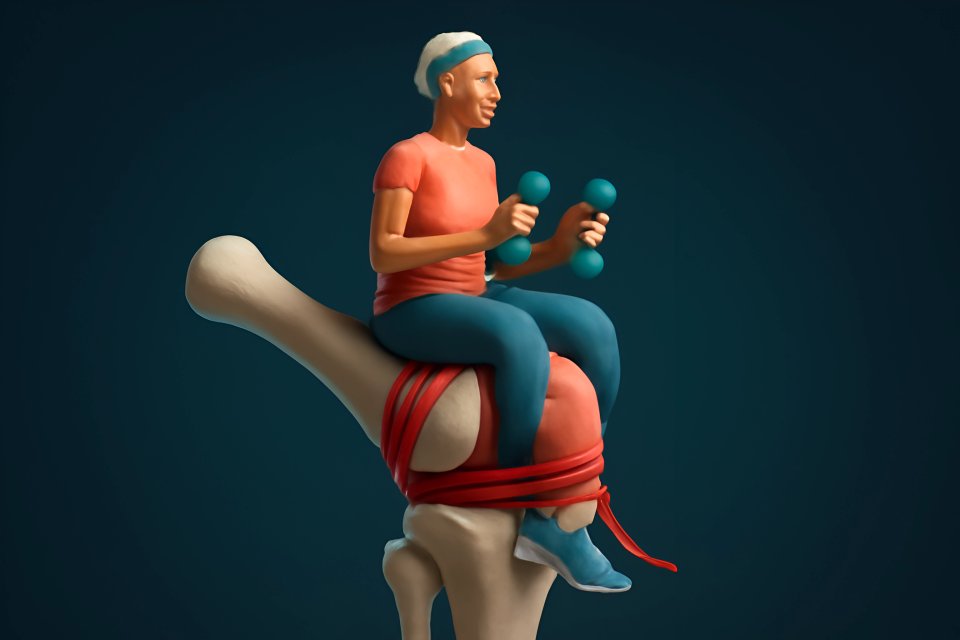
That sharp twinge. The sudden ache that stops you in your tracks. An injury after 50 feels different, doesn't it? It’s not just the physical pain; it’s the wave of frustration, the fear that your active life is over, and the nagging voice that whispers, "Maybe I should just stop."
But what if that voice is wrong? What if this setback isn't a full stop, but a detour onto a smarter, more resilient path? You’ve built a lifetime of strength and wisdom, and now is the time to use it. The desire to stay active is a powerful force, but it must be balanced with the knowledge of how to protect your body as it heals.
This guide is your roadmap for that journey. We’re going to show you the exact gentle workout modifications for seniors recovering from injury that will keep you moving, build strength safely, and restore your confidence. This isn't about pushing through pain; it's about listening to your body and giving it what it needs to come back stronger than ever.
The Golden Rules of Exercising While Recovering
Before you take a single step or lift a single weight, you must build a foundation of safety. Think of these as the non-negotiable laws of smart recovery. Ignoring them is a fast track to re-injury and frustration, but embracing them is your key to a successful comeback.
Get the Green Light First
This is the most important rule of all: talk to your doctor or physical therapist. Before you even think about modifying a workout, you need a professional diagnosis and clearance. They understand your specific injury and can provide personalized advice that generic plans can't. According to experts, a structured rehab program designed by professionals is critical for preventing complications and ensuring a safe return to activity.
Your healthcare provider isn't a gatekeeper; they are your most valuable teammate in this recovery process. They will help you understand your limits and set realistic goals. Starting without their approval is like navigating a minefield blindfolded—a risk you simply can't afford to take.
Listen to Your Body (The "No Pain, More Gain" Myth)
Forget everything you’ve ever heard about "no pain, no gain." During recovery, that mantra is dangerous. Your new mantra is simple and powerful: If it hurts, don't do it. You must learn to distinguish between the gentle ache of a working muscle and the sharp, stabbing, or radiating pain that signals a problem.
Muscle fatigue is normal; joint pain is a red flag. Pushing through warning signs will only set you back further. This is an opportunity to become more attuned to your body’s signals, developing an intuition that will serve you for the rest of your life.
Warm-Up and Cool-Down are Non-Negotiable
When you’re healthy, a warm-up prepares your body for work. When you’re recovering, it’s even more essential. A gentle, dynamic warm-up increases blood flow to your muscles, lubricates your joints, and prepares your body for movement, reducing the risk of further strain.
Think 5-10 minutes of light movement, like marching in place, arm circles, or gentle leg swings. Likewise, a cool-down with light, static stretching helps improve flexibility and signals to your body that it’s time to begin the repair process. Never skip these crucial steps; they are the bookends of a safe and effective workout.
Focus on Form, Not Intensity
Your ego might want to lift the same weights or go at the same pace as before, but your body needs something different right now. The goal is not to break records; it's to heal correctly. Perfect, controlled movements with lighter weight—or even just your bodyweight—are far more beneficial than sloppy, heavy reps.
Slowing down your movements allows you to focus on engaging the correct muscles and maintaining proper alignment. As physical therapists at Fox Rehab advise, modifying exercises with proper form and comfort is key to maintaining functional strength without causing harm. This meticulous attention to detail will not only protect your injury but also build a stronger, more stable foundation for when you return to full intensity.
Practical Exercise Modifications for Common Aches and Injuries
Now, let's get to the practical solutions. Knowing what not to do is half the battle; knowing the smart, safe alternatives is what keeps you in the game. Here are some of the most effective exercise modifications for older adults dealing with common problem areas.
For Lower Body Recovery (Knees, Hips, Ankles)
The thought of squats or lunges with a tender knee can be terrifying. But avoiding lower body work entirely leads to muscle loss, which can worsen instability. The key is to choose movements that strengthen the supporting muscles without putting direct pressure on the injured joint.
Instead of deep squats or lunges that strain the knees, try Chair Squats. Simply sit down and stand up from a sturdy chair, focusing on using your leg and glute muscles, not your hands. This modification, often recommended in recovery, reduces the range of motion to a pain-free level while still building crucial functional strength. Another excellent option is the Glute Bridge, where you lie on your back and lift your hips, powerfully activating your glutes and hamstrings with zero impact on your knees.
For more isolated work, Seated Leg Lifts are a fantastic way to engage your quadriceps without any weight-bearing pressure. These simple changes allow you to maintain lower body strength, which is essential for balance and mobility, ensuring you can navigate your daily life with confidence. For more ideas on building a safe foundation, explore these practical strength training modifications for seniors with joint pain.
For Back Pain or Core Weakness
A strong core is the bedrock of all movement, but traditional core exercises like crunches can put immense strain on a sensitive back. The goal during recovery is to activate the deep, stabilizing muscles of your core without flexing or twisting the spine.
Instead of crunches, start with a gentle Pelvic Tilt. Lying on your back with knees bent, simply press your lower back gently into the floor and release. This small movement awakens the deep transverse abdominis muscle, which acts as a natural corset for your spine. For a next step, the Bird-Dog exercise, performed on all fours by extending the opposite arm and leg, is a powerhouse for building core stability and balance with minimal spinal load.
When it comes to cardio, high-impact activities like running or jumping are off the table. Instead, embrace the healing properties of water. Water aerobics or simply walking in a pool provides resistance to build strength while the water's buoyancy supports your body, removing nearly all impact from your spine and joints. This makes it one of the safest and most effective safe workout routines for injured seniors.
For Upper Body Recovery (Shoulders, Wrists)
An injury to the shoulder or wrist can make everyday tasks feel impossible, let alone a workout. Pushing through exercises like overhead presses or floor push-ups is a recipe for disaster. The solution is to modify the angle and the type of resistance to keep the joints safe.
Instead of floor push-ups, move to the wall. Wall Push-ups allow you to adjust the intensity simply by changing how far your feet are from the wall. This protects the delicate shoulder joint while still strengthening your chest, shoulders, and triceps. For pulling movements, swap heavy dumbbells for resistance bands. Seated or Standing Resistance Band Rows provide controlled tension to strengthen your back muscles, which are vital for good posture, without the joint stress of heavy weights.
Even simple exercises like bicep curls can be modified. If dumbbells aggravate your wrist, try using lighter objects like soup cans or even just focusing on contracting the muscle without any weight at all. These adaptive resistance training techniques for seniors ensure you can maintain upper body strength without compromising your recovery.
Beyond the Workout: Holistic Habits for a Stronger Recovery
True healing doesn't just happen in the gym. Your body is a complex system, and a full recovery requires a holistic approach that supports the repair process 24/7. What you do outside of your workout is just as important as the exercises themselves.
First, you must fuel your healing with proper nutrition. Your body needs protein to repair and rebuild damaged muscle tissue. It also needs anti-inflammatory foods, like berries, leafy greens, and fatty fish, to help manage swelling and promote healing. And never underestimate the power of hydration; water is essential for transporting nutrients to your cells and flushing out waste products.
Second, prioritize rest and sleep. Sleep is when your body does its most critical repair work, releasing growth hormone and dedicating energy to healing tissues. According to RWJBarnabas Health, adequate sleep is a critical component of injury recovery, yet it's often the first thing we sacrifice. Aim for 7-9 hours of quality sleep per night to give your body the best possible chance to heal.
Finally, don't neglect the mind-body connection. An injury can be mentally and emotionally taxing. Gentle activities like mindful stretching, deep breathing exercises, or meditation can help manage the stress of recovery and keep you positively connected to your body. Consider exploring a home mobility routine to improve joint health as a way to combine gentle movement with mindfulness.
Putting It All Together: A Sample Gentle Weekly Schedule
Seeing how these pieces fit together can make starting feel less overwhelming. Below is a sample template for a gentle weekly schedule. Remember, this is just an example. You must adjust it based on your specific injury and your doctor's advice.
| Day | Activity | Focus |
|---|---|---|
| Day 1 | Gentle Cardio (15-20 min) + Full Body Gentle Stretches | Increase blood flow and maintain mobility. |
| Day 2 | Modified Strength (2-3 exercises for upper & lower body) | Rebuild strength safely using modifications from Section 3. |
| Day 3 | Active Recovery | Light stretching or a very short, slow walk. Listen to your body. |
| Day 4 | Modified Strength (Focus on core & back exercises) | Build core stability to support the entire body. |
| Day 5 | Gentle Cardio (15-20 min) | Maintain cardiovascular health with low-impact options. |
| Day 6 & 7 | Rest | Allow your body crucial time to repair and rebuild. |
Conclusion: Embrace the Journey, Not Just the Destination
An injury is not a sign of weakness or a signal to give up. It is your body's way of demanding that you listen, adapt, and grow smarter. Recovery is a process of rediscovering your strength, not through brute force, but through patience, wisdom, and gentle persistence. By embracing modifications, listening to your body, and seeking professional guidance, you are not just healing an injury—you are building a more durable, resilient foundation for a lifetime of fitness.
You have the experience and the wisdom that comes with living a full life. Use it. This journey is a testament to your strength, not a deviation from it. You are capable, you are strong, and you will come back from this. Once you feel confident, you can learn how to build a low-impact exercise routine over 50 that will keep you active for years to come.
What's one modification that has helped you on your recovery journey? Share your experience in the comments below to inspire our FitOverFifty community!
FAQ Section
How do I know if I'm pushing myself too hard during recovery?
Focus on the "pain rule"—stop immediately if you feel sharp, stabbing, or increasing pain. Mild muscle soreness a day or two after a workout is often okay, but sharp pain during the activity or any pain in the joint itself is a clear red flag that you need to stop and reassess.
Can I still do cardio while recovering from a lower-body injury?
Yes! This is a perfect time to explore low-impact cardio options that don't stress your lower body. Swimming and water aerobics are ideal because the water supports your weight. You can also use an arm bike (ergometer) or a stationary bike if it doesn't aggravate your specific injury.
How long should I wait to return to my normal workout routine after an injury?
There is no one-size-fits-all answer to this question. The timeline is unique to your injury, your body's healing process, and your overall health. This must be determined by your doctor or physical therapist, who can guide you through a gradual, phased approach to ensure you don't do too much, too soon.















